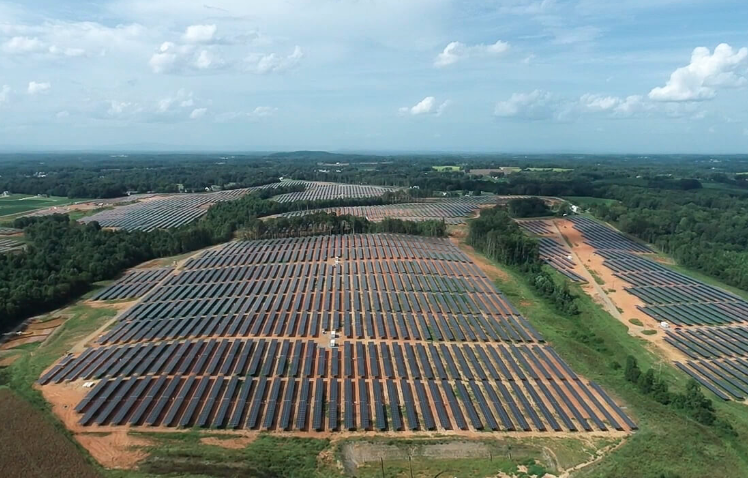
By GARY D. ROBERTSON Associated Press
RALEIGH, N.C. (AP) — Duke Energy Corp. offered Tuesday updated proposals on how it would meet mandated greenhouse gas emissions reductions in North Carolina through increasing solar and wind power generation and replacing outgoing coal-fired plants in part with new nuclear and hydrogen technologies.
A landmark 2021 law directed the North Carolina Utilities Commission to create an ongoing plan by which the state’s electric public utilities — essentially Duke Energy Carolinas and Duke Energy Progress — would reduce carbon dioxide emissions by 70% by 2030 as compared with 2005 levels. The law also calls for net-zero emissions by 2050.
The law does allow the panel to delay the 70% carbon dioxide reduction goal well beyond 2030 in the interest of protecting electric grid supplies or if it should authorize certain nuclear and wind-generation construction.
With these exceptions and other principles in mind, Duke Energy executives said their plan going to the commission later this week but made public late Tuesday says the utility favors reaching the target in 2035.
“We believe that (the 2035 target portfolio) is the most reliable and most affordable pathway for North Carolinians,” Duke Energy North Carolina President Kendal Bowman said in an interview. Bowman added it is ultimately up to the commission to determine “the pace and the resource mix for North Carolina’s clean energy transition.”
The company said it has already reduced emissions by 46% compared with 2005. But a five-year deferral will bring opposition from the utility’s critics, who said later Tuesday that Duke’s plan continues to rely too heavily on natural gas and fails to embrace federal incentives enough to build out renewable energy.
“We trust that the Utilities Commission will recognize the lack of ambition in Duke’s carbon plan proposal, which risks not meeting the state’s climate and affordability targets at a time when leadership and urgency is needed,” Luis Martinez, an attorney with the Natural Resources Defense Council, said in a news release.
The commission entered its initial carbon plan order last December after getting proposals from Duke Energy and input from environmental groups and electricity consumers earlier in the year.
Unlike Duke’s initial 2022 plan that proposed several different portfolio options, the seven-member panel chosen by Gov. Roy Cooper instead directed the utility to carry out activity to generate electricity and backed Duke’s plan to retire fully its coal-fired fleet by 2035.
The law tells the commission to update its plan every two years, and the Duke subsidiaries’ “Carolinas Resource Plan” begins that process, with public hearings anticipated next spring.
Charlotte-based Duke, whose two subsidiaries serve 3.7 million customers in North Carolina, offered to the commission Tuesday three portfolio mixes that respectively would meet the 70% reduction target by 2030, 2033 and 2035.
Each would raise customer power bills, according to the utility’s projections, with the 2035 portfolio costing the least monetarily. For example, the filing says that the most aggressive portfolio — meeting the 70% standard by 2030 — would add another $60 to an average monthly residential customer bill by 2033 and $70 by 2038. By meeting the standard by 2035, similar bills would go up by $35 by 2033 and $55 by 2038.
Duke’s recommended 2035 portfolio includes a “near-term action plan” that would build up additional solar and wind generation and provide more electricity storage in batteries by the early 2030s.
The company also would plan to retrofit its Roxboro, Marshall and Belews Creek coal-fired plants with new technologies.
While the Roxboro and Marshall plants would shift to using natural gas that runs through turbines, generating electricity, Duke says those plants also would be able to use hydrogen to produce energy.
At Belews Creek, which is already a coal and natural-gas fired plant, the utility proposes building an “advanced nuclear” plant at the site that by 2035. These operations are smaller and more efficient than traditional nuclear reactors.
Duke Energy contends that its preferred portfolio best addresses the state’s growing population and industries, along with environmental mandates.
“The plan is balancing those objectives that allow us to both retire the coal and meet that load growth in a way that’s affordable for customers,” said Glen Snider, the utility’s managing director of integrated resource planning and analytics.
Tuesday’s plan also would seek to increase the utility’s electricity reserves to respond to peak demand times, Snider said.
The provision follows unprecedented rolling blackouts last Christmas Eve in Duke’s North Carolina coverage area that was blamed in part on extreme cold, malfunctioning plant equipment and the inability to buy power on the regional transmission system.
The 2035 portfolio also would increase generation at a Duke hydroelectric plant in Oconee County, South Carolina, which serves Duke customers in both states. Duke Energy said the same plan was filed Tuesday with South Carolina regulators, who will examine it separately.